Expressive
Intersections
in Brahms
MUSICAL MEANING AND INTERPRETATION
Robert S. Hatten, editor
EDITED BY
HEATHER PLATT
AND
PETER H. SMITH
Expressive
Intersections
in Brahms
Essays in Analysis and Meaning
INDIANA UNIVERSITY PRESS
Bloomington and Indianapolis
This book is a publication of
indiana University Press
601 north morton Street
Bloomington, indiana 47404-3797 USA
iupress.indiana.edu
Telephone orders 800-842-6796
Fax orders 812-855-7931
2012 by Indiana University Press
All rights reserved
No part of this book may be reproduced or utilized in any form or by any means, electronic or mechanical, including photocopying and recording, or by any information storage and retrieval system, without permission in writing from the publisher. The Association of American University Presses Resolution on Permissions constitutes the only exception to this prohibition.
 The paper used in this publication meets the minimum requirements of the American National Standard for Information SciencesPermanence of Paper for Printed Library Materials, ANSI Z39.481992.
The paper used in this publication meets the minimum requirements of the American National Standard for Information SciencesPermanence of Paper for Printed Library Materials, ANSI Z39.481992.
MANUFACTURED IN THE UNITED STATES OF AMERICA
Library of Congress Cataloging-in-Publication Data
Expressive intersections in Brahms : essays in analysis and meaning / [edited by] Heather Platt and Peter H. Smith.
p. cm. (musical meaning and interpretation)
Includes bibliographical references and index.
ISBN 978-0-253-35705-2 (cloth : alk. paper) ISBN 978-0-253-00525-0
(e-book) 1. Brahms, Johannes, 18331897Criticism and interpretation.
I. Platt, Heather Anne. II. Smith, Peter Howard.
ML410.B8E77 2012
780.92dc23
2011031951
1 2 3 4 5 17 16 15 14 13 12
Contents
Acknowledgments
The impetus for a volume of essays exploring intersections of consummate technical craft and profound expressivity in Brahmss music arose from discussions with members of the Board of directors of the american Brahms Society. We are indebted to the society for its encouragement and for its generous subvention to defray expenses associated with the production of this book. The society has supported five other volumes: Brahms Studies: Analytical and Historical Perspectives, ed. George S. Bozarth (Oxford: Clarendon Press, 1990); Brahms Studies 13, ed. david Brodbeck (lincoln: University of nebraska Press in affiliation with the american Brahms Society, 1994, 1998, and 2001); and On Brahms and His Circle: Essays and Documentary Studies by Karl Geiringer, ed. George S. Bozarth (Sterling Heights, mich.: Harmonie Park Press in association with the american Brahms Society, 2006). Expressive Intersections in Brahms: Essays in Analysis and Meaning complements and extends these works by bringing together some of the most recent scholarly approaches to the analysis and hermeneutic interpretation of Brahmss compositions.
From the very early stages of the project, robert Hatten, series editor, and Jane Behnken, sponsoring editor, at indiana University Press have demonstrated their unflagging support. We are grateful for their guidance through the various stages of work on this volume and for their assistance in arranging for the illustrations that appear in chapters 3 and 4. robert gave generously of his time, perceptively reading each of the essays as they were completed; all our authors have benefited from his editorial acumen. a number of other scholars also offered advice at the very earliest stages, when the concept of the volume was only beginning to emerge: we are grateful for the counsel of richard Cohn, roe-min Kok, and Joseph n. Straus. We would also like to acknowledge the constructive criticisms of the anonymous scholars who reviewed our initial proposal for the press; in particular, we greatly appreciate l. Poundie Bursteins advice and encouragement.
We were fortunate to have contributors who immediately recognized the merits of the project. They conceived fascinating essays, each of which brings a unique voice to the volume, and they graciously participated in discussions throughout the editorial process. aside from the stimulating ideas offered by the authors, both in their essays and in e-mail exchanges, we greatly appreciated their unfailingly prompt responses to our queries and concerns. in particular, we acknowledge Steven rings, who read and commented on our first chapter, The Wondrous transformation of Thought into Sound: Some Preliminary reflections on musical meaning in Brahms.
Travis Jeffords set the musical examples in chapters 4, 5, 8, and 9. it was a pleasure to work with an engraver with such a superb eye for detail and who quickly attended to even the slightest correction or alteration. The examples in the other chapters were prepared by the respective authors; their ability to adapt their finely tuned design techniques to a uniform style greatly eased the burdens of production of the final volume.
Finally, we are especially indebted to our families: Peters wife and son, lumi and manny, and Heathers husband, mark Kaplan. They too gave their love, time, and patience to this project in far too many ways to enumerate here.
Part One
The Wondrous Transformation of Thought into Sound: Some Preliminary Reflections on Musical Meaning in Brahms
Heather Platt and Peter H. Smith
From where he sat, Clive tried to prevent his attention from being drawn into technical detail. For now, it was the music, the wondrous transformation of thought into sound.... Sometimes Clive worked so hard on a piece that he could lose sight of his ultimate purposeto create this pleasure at once so sensual and abstract, to translate into vibrating air this nonlanguage whose meanings were forever just beyond reach, suspended tantalizingly at a point where emotion and intellect fused.
Ian McEwan, Amsterdam
Although the omniscient narrator of Ian McEwans novel Amsterdam attributes these thoughts to a fictional late twentieth-century British composer, Clive Linley, contemplating his own composition, Linleys reflections capture something of the universal mystery of music. The dualities the narrator develops between technical detail and wondrous transformation, between thought and sound, between hard work and sensual pleasure also resonate strongly with the unique musical persona of Johannes Brahms, a composer whose works have long been admired for their highly wrought craftsmanship as well as for their expressive immediacy. So, too, do the narrators words capture something of the challenge faced by the music scholar dedicated to the close study of Brahmss compositions. How does one remain attuned to Brahmss abundant compositional craftthe fruits of the composers hard labor and a self-conscious emblem of his works individualitywithout losing sight of the musics sensual beauty? Moreover, how do we engage a musical language that, while not strictly referential, nevertheless possesses deep meaning?
Despite the acuity of McEwans narrative voice (not to mention the beauty of his prose), the thoughts this voice attributes to the composer Linley remain somewhat marred by an abundance of potentially false dichotomies. Rather than accept the assumption that emotion and intellect stand at odds in Brahmsthat we, like Clive Linley, need to avoid being drawn into technical details in order to appreciate the wondrous transformation of thought into sound, to appreciate musical meaning, in other wordsthe authors in this volume see these characteristics as inextricably linked. Our view and a premise underlying each essay is not that Brahmss music is meaningful in spite of its organizational intricacy but rather that meaning and technical complexity form an intimate bond. These two conceptions of Brahmss musicas a manifestation of powerful intellect and of passionate expressivityinteract dialectically, with meaning poised, as McEwan/Linley would have it, at the intersection of emotion and reason.



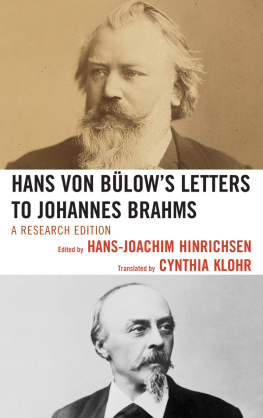
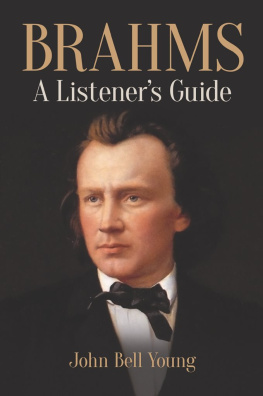

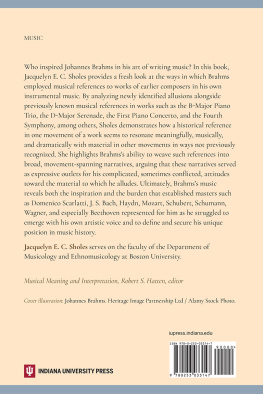

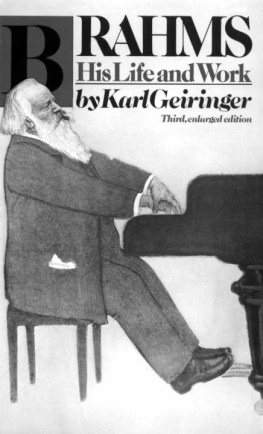
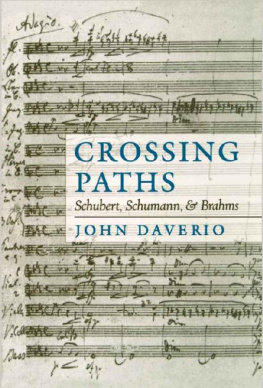
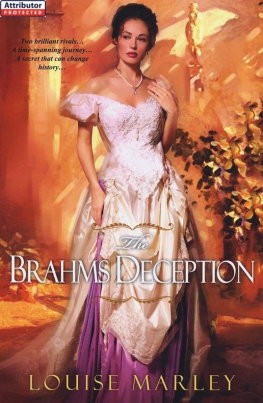
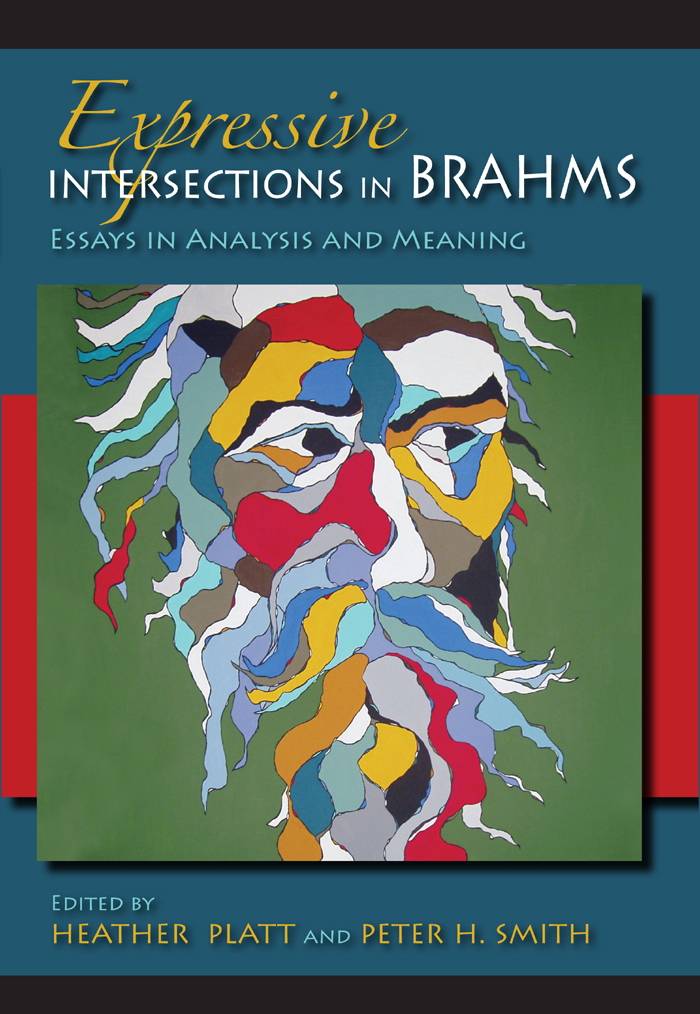
 The paper used in this publication meets the minimum requirements of the American National Standard for Information SciencesPermanence of Paper for Printed Library Materials, ANSI Z39.481992.
The paper used in this publication meets the minimum requirements of the American National Standard for Information SciencesPermanence of Paper for Printed Library Materials, ANSI Z39.481992.